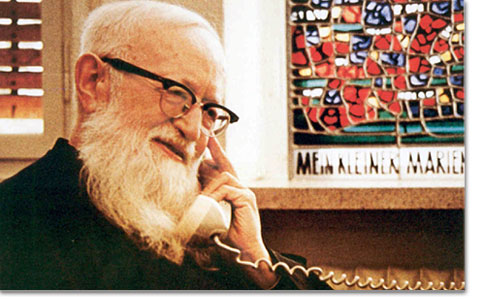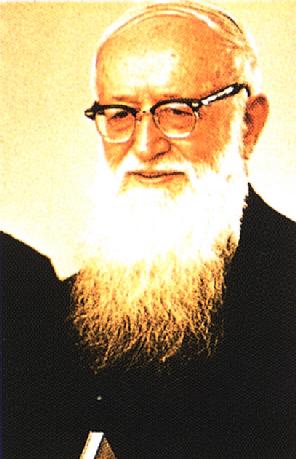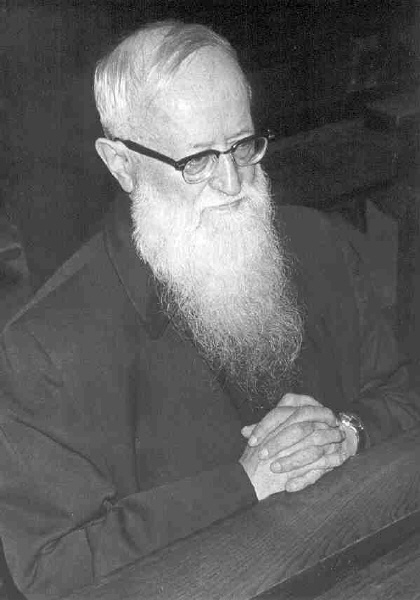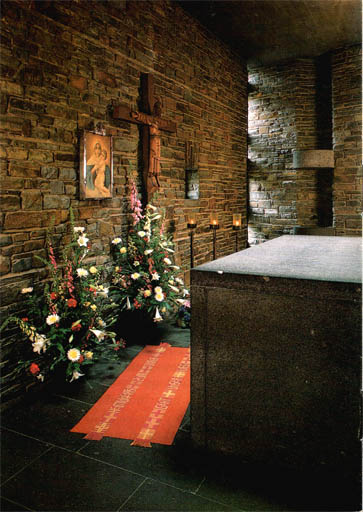Considered by many of those who came into contact with him to have been a saint, his cause for sainthood is currently at the diocesan level in the Diocese of Trier, pending the compilation of his writings and correspondences.
He was born in Gymnich, near Cologne, on November 16, 1885 and christened Peter Josef Kentenich the next day at the parish church of St. Kuniberts. A sickly, illegitimate boy in imperial Germany, he faced many difficulties in his early life. From the age of nine he had a strong devotion to the Virgin Mary whom he credited with bringing him through his life's many trials.
He joined the seminary at an early age, by which time he already knew he wanted to become a priest. Nevertheless, the following years were very difficult for him. He had a very strong sense of truth, and constantly questioned his teacher's ideas. There were many things he thought should be different in the way they were taught to relate with God. At the same time, it was not easy for him to get along with his companions. It was only God and the Virgin Mary he felt comfortable with. His mother would visit him sporadically with great concern, especially about his health.
Although he wished to become a missionary in Africa with the Pallottines, his health prevented him, and by his early twenties, he was working as the spiritual director of young men studying for the priesthood. He taught his students that before they could conquer the world, the most important conquest would be within. Inspired by an article about the conversion of Bartolo Longo and the place of pilgrimage that had grown from the Marian shrine he had begun, Josef guided the young men in his care into a covenant of love with the Blessed Virgin Mary, on October 18, 1914, a day that would prove to be the most important in his life. As the Great War began, under his spiritual guidance, young soldiers were striving for sanctity and virtue even in the trenches of history's most horrific war. Some young men offered up their lives as a sacrifice in the hope that their shrine in Schoenstatt could be more than a place of pilgrimage, and become a global movement of holiness and love that would have practical application in people's lives.
Fr. Kentenich interpreted the ideas of his Order's founder, Vincent Pallotti, to be calling for a worldwide effort to involve lay people in apostolic work, and to unite the various factions in the Church. Soon, the Worldwide Apostolic Federation of Schoenstatt was founded, and eventually grew to involve people of every degree of commitment, from every walk of life, in a free association of people united by the "Covenant of Love". This movement was named after its place of origin, a word meaning beautiful place.
During the Nazi Regime in Germany, he was interrogated by the Gestapo and incarcerated in their prison in Koblenz. He was sent to the feared Dachau concentration camp, having chosen on January 20, 1940, after clandestinely celebrating Mass in his cell, not to sign a health waiver to escape the punishment for his outspoken opposition to Hitler's regime. He spent over three years in the camp, where he became a support for many, especially among the Priests, and according to firsthand accounts, he guided many prisoners to show compassion, instead of degenerating into animalistic behavior, to be good men even in the midst of certain death. In Dachau, new branches of the Schoenstatt Movement, including its first international and family branches, were founded.
After the liberation of Dachau by the Allies, Father Kentenich continued his work in building the Schoenstatt Family all over the world. With a Vatican passport, he travelled to South Africa, the United States of America and many nations in Latin America. During this time, the Schoenstatt Movement was examined by authorities of the Church in Germany. In Bellavista, Chile, on 31 May 1949, Kentenich wrote a letter as an answer to the report of the visitation, which set forth his teachings about the mechanistic thinking that he claimed was endangering modern theological thought. Fr. Kentenich, who could have chosen to remove himself voluntarily from the movement, was ordered to leave Schoenstatt by order of the Church authorities, although with little or no knowledge of the highest Vatican authorities, and sent to Milwaukee in the USA. He remained there for fourteen years, showing loyalty and obedience to the Church to his followers by his silent and powerful example. At the end of 1965, a mysterious telegram recalled him to Rome, where he was received with much bewilderment, just as the Second Vatican Council was drawing to a close. However, as the reforms of the Council confirmed what Fr. Kentenich had prophetically been teaching for decades, he was permitted to stay in Rome for the closing of the Council, rehabilitated by Pope Paul VI, and sent back to Schoenstatt. He arrived on Christmas Eve, in time to say midnight Mass in the original Shrine of Schoenstatt.
In the three years left to him at the end of his exile in 1965, he dedicated his time and energy to be a father to countless visitors from his international Schoenstatt Family, as well as spending hours in prayer. He was known to throw fruit from his window, and an amazing number of people still own small gifts, cards, and letters that he showered upon those who sought, and found in him the assurance of a loving God, and the courage to attempt to change the world for the better. After celebrating Holy Mass, Fr. Kentenich died in the sacristy of the newly constructed church of the Blessed Trinity on Mt. Schoenstatt on September 15, 1968, aged 82. He is buried in this room, in a large stone sarcophagus inscribed with the Latin words DILEXIT ECCLESIAM - He Loved the Church.
The process for his beatification was opened on February 10, 1975. When some of Fr. Kentenich's supporters greeted Pope John Paul II with the words, "Canonize Father Kentenich!" he smiled and returned, "You canonize him!" implying that canonization is not to be seen as merely a bureaucratic process, but an acclamation of a heroic, virtuous person by the people. To this day, devotion to Joseph Kentenich is spreading and awareness of his contributions to educational, philosophical, theological, social, and other thought are being translated and disseminated.
Considered by many of those who came into contact with him to have been a saint, his cause for sainthood is currently at the diocesan level in the Diocese of Trier, pending the compilation of his writings and correspondences.
He was born in Gymnich, near Cologne, on November 16, 1885 and christened Peter Josef Kentenich the next day at the parish church of St. Kuniberts. A sickly, illegitimate boy in imperial Germany, he faced many difficulties in his early life. From the age of nine he had a strong devotion to the Virgin Mary whom he credited with bringing him through his life's many trials.
He joined the seminary at an early age, by which time he already knew he wanted to become a priest. Nevertheless, the following years were very difficult for him. He had a very strong sense of truth, and constantly questioned his teacher's ideas. There were many things he thought should be different in the way they were taught to relate with God. At the same time, it was not easy for him to get along with his companions. It was only God and the Virgin Mary he felt comfortable with. His mother would visit him sporadically with great concern, especially about his health.
Although he wished to become a missionary in Africa with the Pallottines, his health prevented him, and by his early twenties, he was working as the spiritual director of young men studying for the priesthood. He taught his students that before they could conquer the world, the most important conquest would be within. Inspired by an article about the conversion of Bartolo Longo and the place of pilgrimage that had grown from the Marian shrine he had begun, Josef guided the young men in his care into a covenant of love with the Blessed Virgin Mary, on October 18, 1914, a day that would prove to be the most important in his life. As the Great War began, under his spiritual guidance, young soldiers were striving for sanctity and virtue even in the trenches of history's most horrific war. Some young men offered up their lives as a sacrifice in the hope that their shrine in Schoenstatt could be more than a place of pilgrimage, and become a global movement of holiness and love that would have practical application in people's lives.
Fr. Kentenich interpreted the ideas of his Order's founder, Vincent Pallotti, to be calling for a worldwide effort to involve lay people in apostolic work, and to unite the various factions in the Church. Soon, the Worldwide Apostolic Federation of Schoenstatt was founded, and eventually grew to involve people of every degree of commitment, from every walk of life, in a free association of people united by the "Covenant of Love". This movement was named after its place of origin, a word meaning beautiful place.
During the Nazi Regime in Germany, he was interrogated by the Gestapo and incarcerated in their prison in Koblenz. He was sent to the feared Dachau concentration camp, having chosen on January 20, 1940, after clandestinely celebrating Mass in his cell, not to sign a health waiver to escape the punishment for his outspoken opposition to Hitler's regime. He spent over three years in the camp, where he became a support for many, especially among the Priests, and according to firsthand accounts, he guided many prisoners to show compassion, instead of degenerating into animalistic behavior, to be good men even in the midst of certain death. In Dachau, new branches of the Schoenstatt Movement, including its first international and family branches, were founded.
After the liberation of Dachau by the Allies, Father Kentenich continued his work in building the Schoenstatt Family all over the world. With a Vatican passport, he travelled to South Africa, the United States of America and many nations in Latin America. During this time, the Schoenstatt Movement was examined by authorities of the Church in Germany. In Bellavista, Chile, on 31 May 1949, Kentenich wrote a letter as an answer to the report of the visitation, which set forth his teachings about the mechanistic thinking that he claimed was endangering modern theological thought. Fr. Kentenich, who could have chosen to remove himself voluntarily from the movement, was ordered to leave Schoenstatt by order of the Church authorities, although with little or no knowledge of the highest Vatican authorities, and sent to Milwaukee in the USA. He remained there for fourteen years, showing loyalty and obedience to the Church to his followers by his silent and powerful example. At the end of 1965, a mysterious telegram recalled him to Rome, where he was received with much bewilderment, just as the Second Vatican Council was drawing to a close. However, as the reforms of the Council confirmed what Fr. Kentenich had prophetically been teaching for decades, he was permitted to stay in Rome for the closing of the Council, rehabilitated by Pope Paul VI, and sent back to Schoenstatt. He arrived on Christmas Eve, in time to say midnight Mass in the original Shrine of Schoenstatt.
In the three years left to him at the end of his exile in 1965, he dedicated his time and energy to be a father to countless visitors from his international Schoenstatt Family, as well as spending hours in prayer. He was known to throw fruit from his window, and an amazing number of people still own small gifts, cards, and letters that he showered upon those who sought, and found in him the assurance of a loving God, and the courage to attempt to change the world for the better. After celebrating Holy Mass, Fr. Kentenich died in the sacristy of the newly constructed church of the Blessed Trinity on Mt. Schoenstatt on September 15, 1968, aged 82. He is buried in this room, in a large stone sarcophagus inscribed with the Latin words DILEXIT ECCLESIAM - He Loved the Church.
The process for his beatification was opened on February 10, 1975. When some of Fr. Kentenich's supporters greeted Pope John Paul II with the words, "Canonize Father Kentenich!" he smiled and returned, "You canonize him!" implying that canonization is not to be seen as merely a bureaucratic process, but an acclamation of a heroic, virtuous person by the people. To this day, devotion to Joseph Kentenich is spreading and awareness of his contributions to educational, philosophical, theological, social, and other thought are being translated and disseminated.
Sponsored by Ancestry
Advertisement
Explore more
Sponsored by Ancestry
Advertisement






